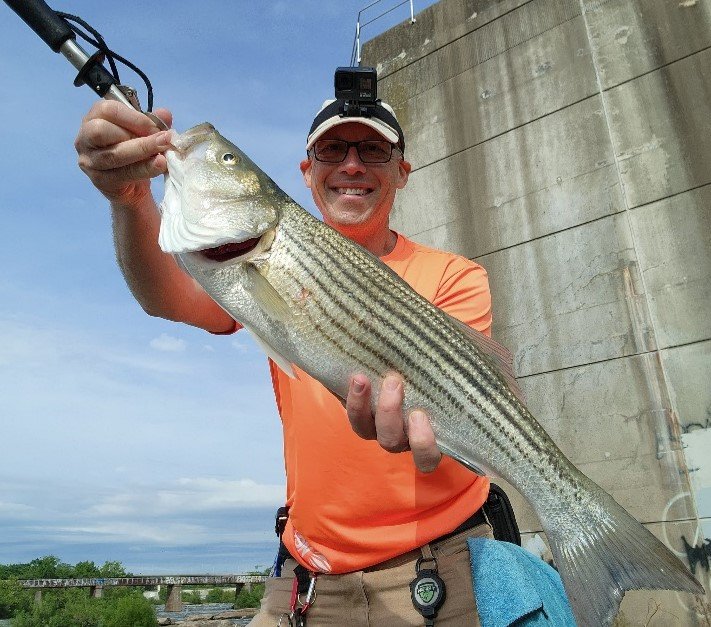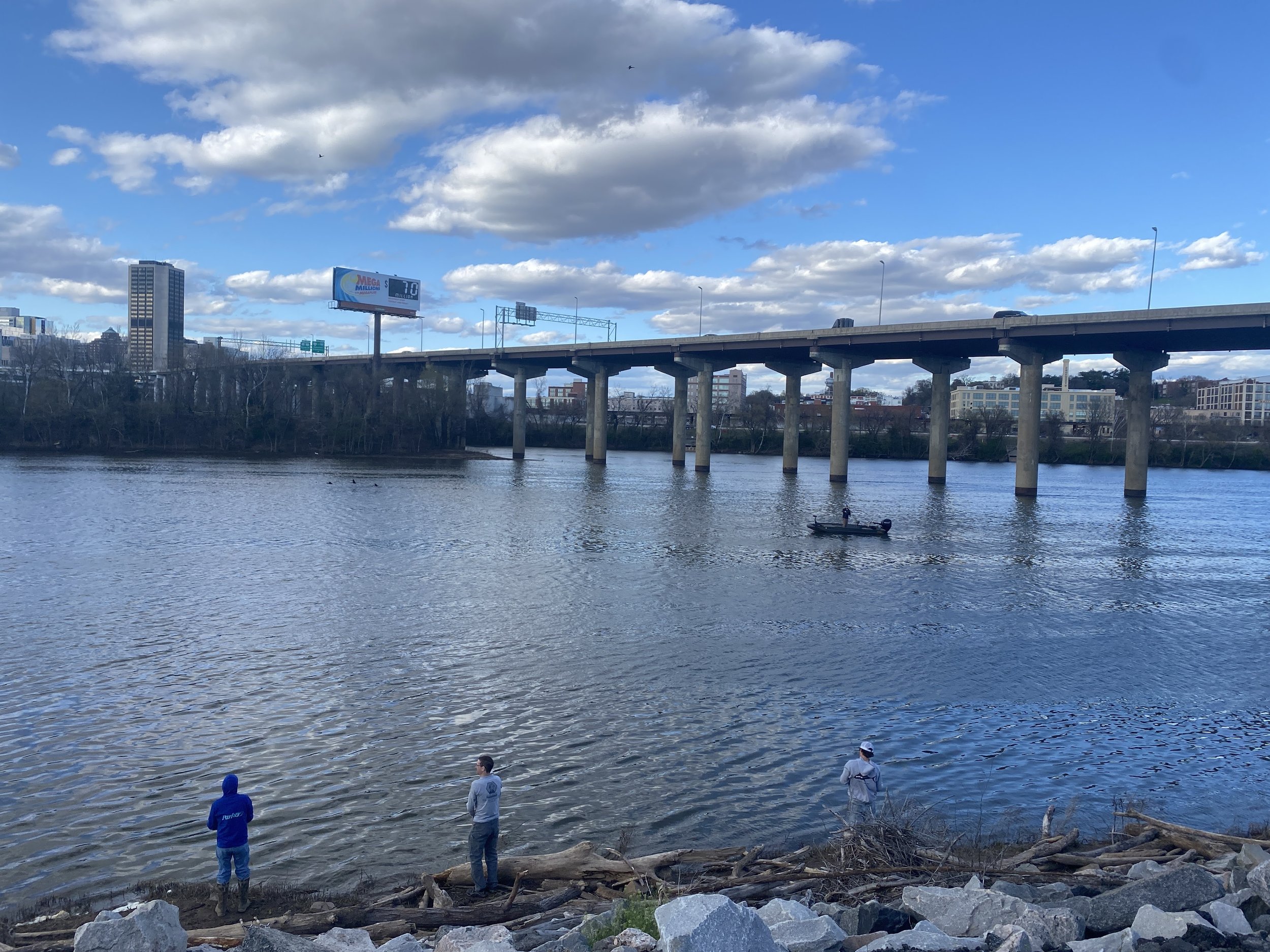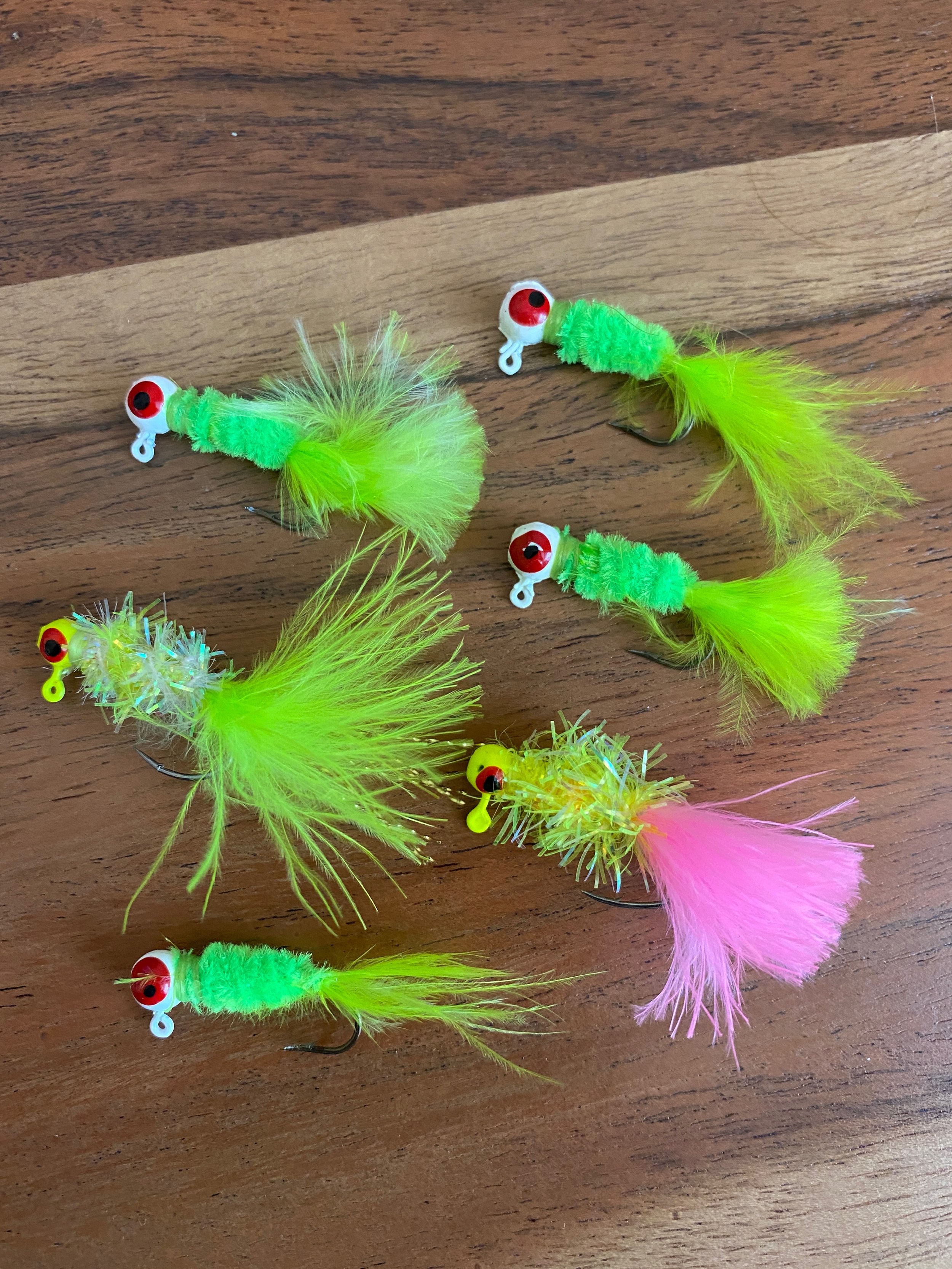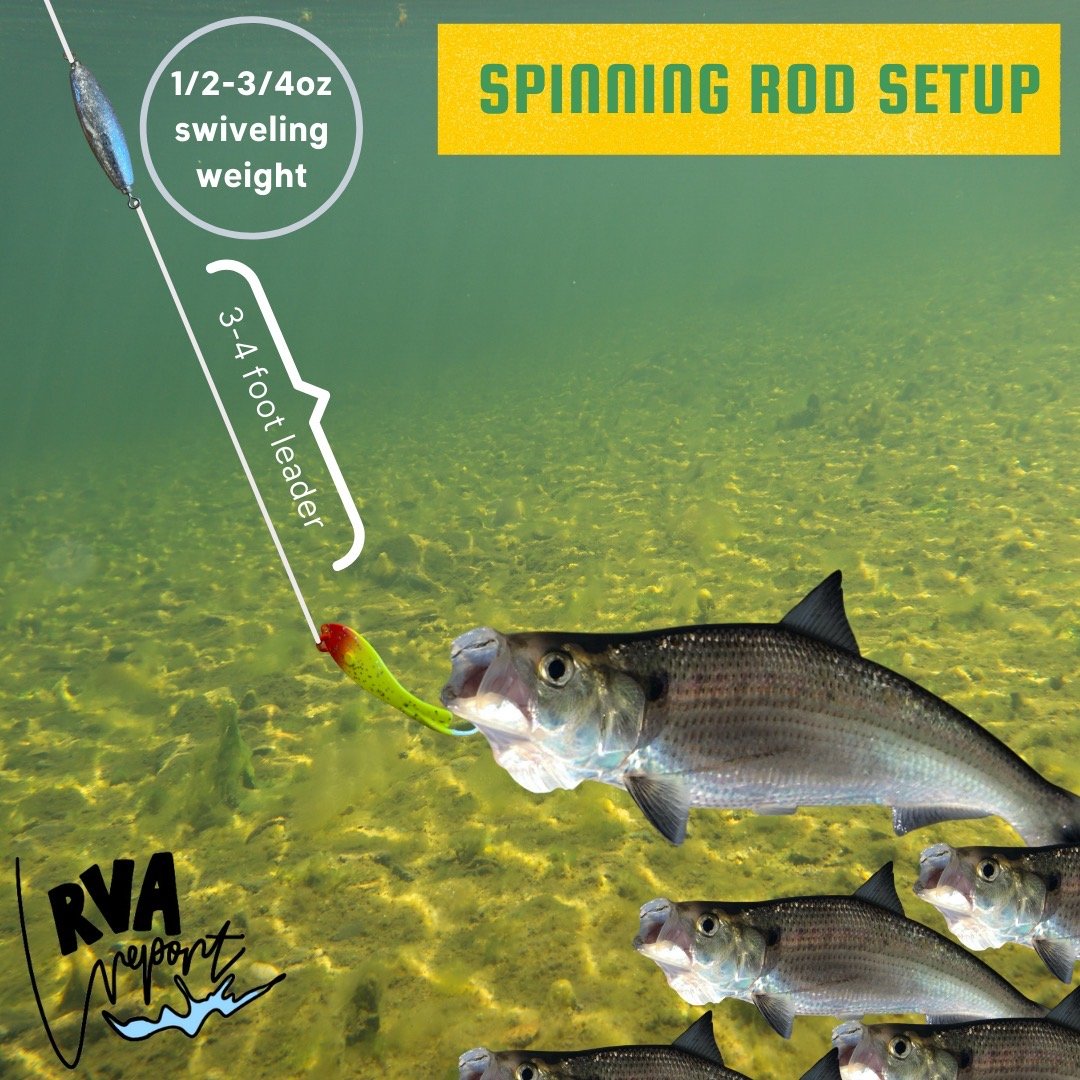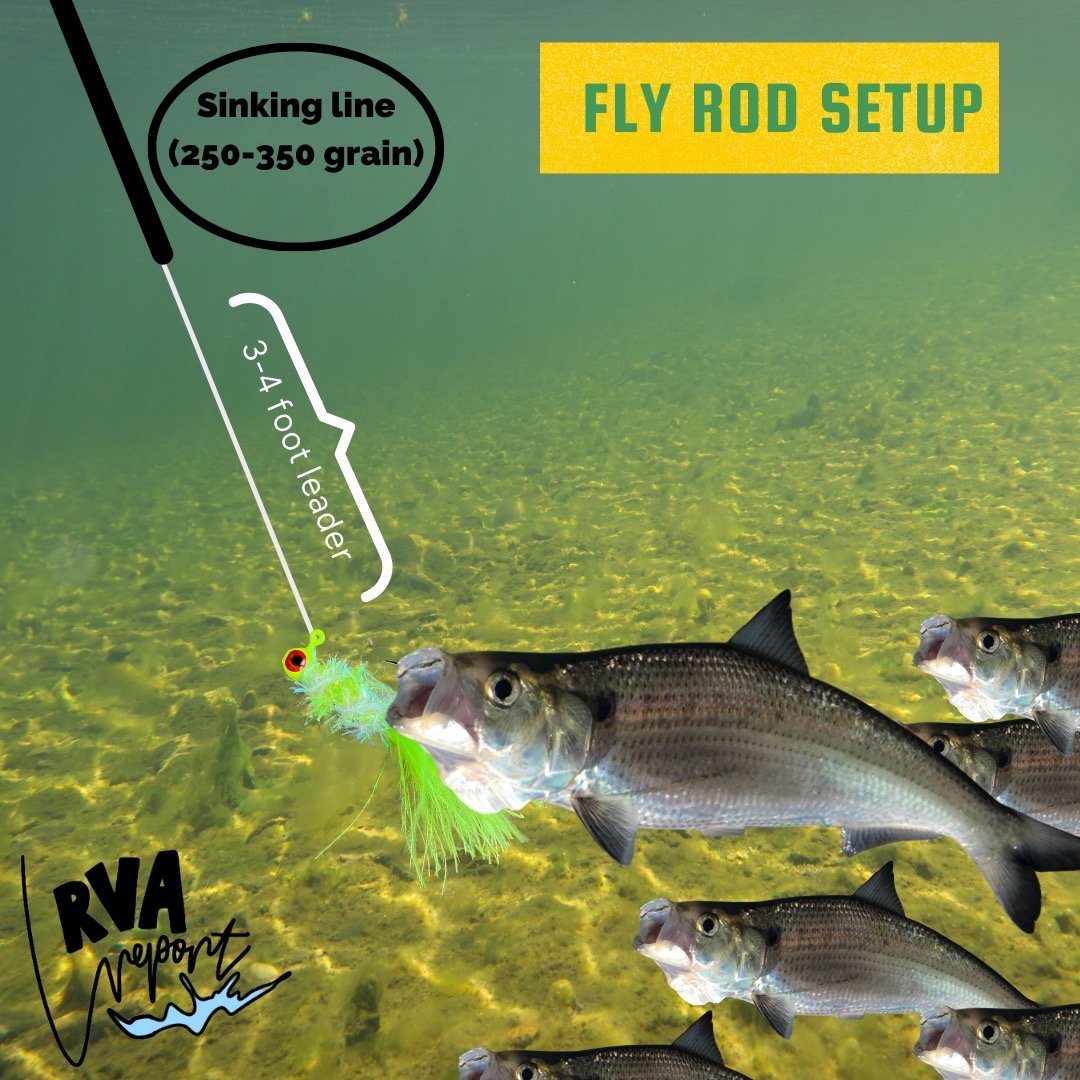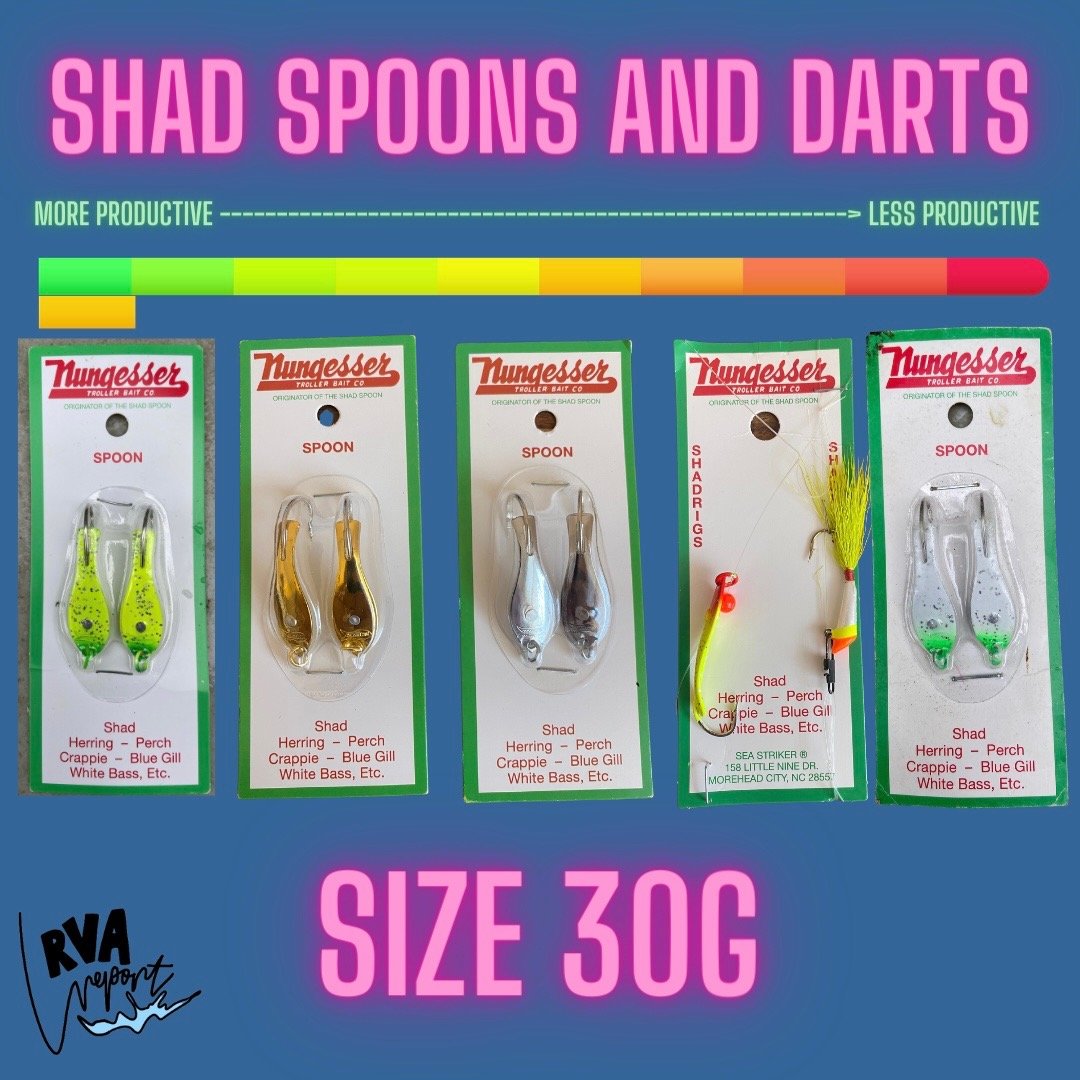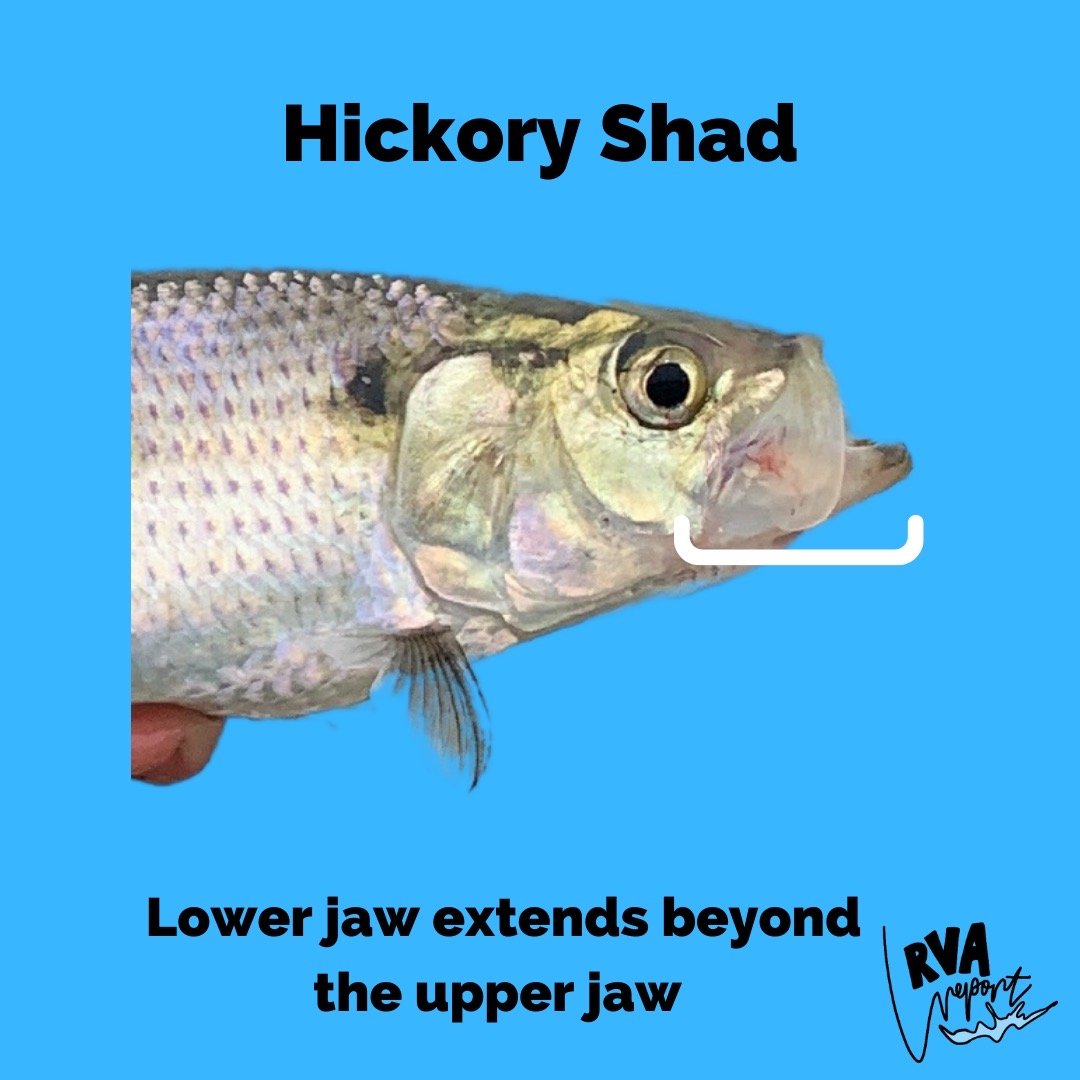White, black and fluffy: a tale of the striped bass run
Not every striper fishing adventure on the James River is met with success. Read a short story about fishing for striped bass on the James River.
The painful blast of my morning alarm startled me. It was earlier than normal, and my body still ached from squeezing in an evening run the night before. Early starts to the day are a half-habit for me. I don’t build them into my schedule for the week but appreciate the sense of accomplishment they provide, especially when the striped bass are making their spring run up the James River.
There’s no excuse to sleep through a dawn striper session living in Richmond, as these aggressive fish are only residents in our stretch of river for a few months, and you never know how many productive outings you’ll score each season.
Stripers are always moving in and out of the rapids around the fall line during the spring months, and they often appear out of nowhere at times you least expect.
What does this mean? Long hours, dozens of lost lures, and many sleep-deprived nights, all of which can lead to the dreaded return to the car without a fish landed in the net.
So, back to the start of my morning adventure. After I threw back a mug of coffee, strapped on my Chacos and tossed a peanut butter sandwich in my car, along with an extra pair of work clothes, I dashed down I-95 toward the James.
I was eager for a topwater explosion, so the trusty Cotton Cordell was my first-choice lure of the day. It was late in May, so the chances for surface action were strong. The sun had broken the horizon, and it was still that perfect early morning light that tends to draw a few attacks on the surface. As I hurled my Cordel into the main section of the riffle, I felt myself anticipating an attack and slowly twitched the plug in a delicate criss cross motion, giving the action of a struggling herring slowly losing steam.
Casting a topwater lure and making it dance is entertainment itself, but after the 30th cast without a bump, my faith in Mr. Cordell was starting to dwindle.
I decided to put on my other high-producing lure that usually cancels the chances of a skunk: the five-inch, white paddle tail with a half-ounce jig head. Working this lure slowly and jigging it off the rocky bottom, I felt a sudden stop, almost like I was stuck on the bottom. My heart paused for a second, and I leaned forward and snapped my rod back quickly to set the hook.
I either hooked the fish of my lifetime or was caught on the bottom.
My mind was racing as I envisioned a 30 inch bass dashing out of the water, peeling drag downriver. But to my disappointment, this rockfish was missing the last four letters of its name… As I performed the “banjo” technique to loosen the jig from underneath the rock and release the tension (courtesy of Ron the river legend), one failed attempt after another left me without hope but to cut the line.
I looked down at my watch, and it was almost 9’oclock. Time to call it a morning and head into the office.
James River during striper season
So, you want to catch a striped bass? Me too!
By Ron Binshtok
I'm a largemouth bass fisherman, but not that long ago I found something new to love about the James River: the spring striped bass migration.
As the water temperature approaches 50 degrees, striped bass make their way up from the ocean to spawn, showing up in the river in big numbers. Also arriving to the river in numbers are the anglers, all wanting to catch a striped bass. But maybe you're like I was in the beginning and don't know where to start. That's why I'm writing this post. I want to share my experience both good and bad in hopes that I can make your quest to target these fish less painful, or better yet, more enjoyable.
Getting started.
For me, I jumped in feet first...using my existing largemouth gear, most of which was bait casting setups in the 6.5ft to 7ft range. I used spinnerbaits, lipless crankbaits, and small topwater plugs, most of which I already had. I wasn't familiar with striper fishing setups, so I defaulted to what I (thought) I knew. I learned quickly that my gear underperformed for the fishing style needed. My bait casters were horrible with all the bird-nesting issues I encountered "trying" to sling lures far out into more open water. I couldn't achieve the casting distances needed to target fish in deeper channels from the bank. I tried to compensate by using my 7ft spinning setup, but that got me only so far. I did eventually get lucky and connect with a few stripey fish, but my challenges continued as I struggled to fight and successfully land them. That struggle persisted as my fishing line/leader was too weak and fish would break off either from their intense fighting or the braid would rub against rock and wood, abrading and snapping the line. The James River is notorious for its profusion of debris and structure, often leading to snagged lures. Nine times out of 10, I would break the line trying to free up a snagged lure. Losing several expensive lures adds up quickly and ends with much frustration.
So what did I do with all of this?
I made a conscious effort to watch, listen, and learn from local anglers. From rods to reels to lures, I focused my attention on what experienced fishermen were using. I absorbed details around how the tide, water temperature, and weather conditions affected the movement and feeding patterns of these fish. Knowing what areas of the river attract and hold fish under various river conditions improved my chances of landing these beautiful fish. Much of this information was shared via on-the-job training.
Nothing's better than standing at the water's edge and identifying critical features important to fish movement. For example, under certain tidal or flow conditions, one might find slack water in a particular area. However, under other conditions, that same area might reveal a rock or cluster of debris that juts above the waterline creating eddy currents. Understanding the anatomy of the river and how fish respond to water levels, tides, and time of day can be the difference between casting practice and hauling in multiple fish. I became friends with these river experts, which is not hard to do when you cross paths with them each time you venture out. These friends let me try out their setups to get a feel for what differences exist with my tackle compared to their legit setups better suited for targeting striped bass.
After weeks (months) of observing, researching, and talking to many experienced anglers, along with waiting for tackle inventory to replenish after the season, I invested in two new setups. Both were larger 8ft and 9ft surf rods with beefed-up saltwater-rated spinning reels. These combos were larger than anything I'd owned previously. I was now able to use a higher pound-test (30 to 50lb braid) and heavier leaders (40-50lb fluorocarbon), which made an enormous difference in every aspect of catching these fish.
Now I had my chance to really learn new techniques...from how to tie an FG knot with heavy line (awesome knot, look it up!) to how to throw multi-ounce pencil poppers and large plastic swimbaits. One of the biggest game changers was learning how to successfully free up snagged lures, a rare possibility with a medium-power, 6ft setup. Having a longer rod with a significant backbone, along with an appropriate line/leader, allowed me to finally learn how to break loose lures from all kinds of structure without having to be "gentle". Now I could try what others would call the "banjo" method to unstick lures. I learned this technique from a friend in real-time, as it's nuanced and hard to accurately describe. Essentially, I'd load up the rod under extreme pressure with one hand while simultaneously stretching the line above the reel further away from the rod with the other hand. The line is abruptly released—while keeping pressure on the rod—sending a shockwave down the line toward the snagged lure. Ideally, the snagged hook is dislodged and with it brings a smile of accomplishment to the face of those who have mastered the technique. Join me on the water sometime, and I'll show you how to do it!
So, you still want to catch a striper?
I hope my (limited) experience will help inform and inspire you to catch your own. With a bit of knowledge, connecting with some good people, and having the right setup, you are well on your way to successfully landing these beautiful fish! Just remember to gently release them with care so I can catch 'em next time.
Want to connect? I’m happy to share more details on lure/tackle selection and fishing locations!
Stop by my Instagram & check out my YouTube channel for some of my fishing fun…especially those striper fishing videos!
Until next time, tight lines!
Ron Binshtok
Preparing for shad season
Just above the I-95 bridge on the James River
Preparing for shad season
Whether you’re behind a vise tying chartreuse shad flies or scouring Greentop’s shelves restocking your shad spoon collection, there’s a special feeling/craze/excitement that creeps into every shad angler’s mind this month, in anticipation of what’s right around the corner: SHAD SEASON! While we are still a good month away from the start of mayhem on the James River, you’ll probably see some shiny gold and silver “bling” at checkout lines this time of year as we all prepare for a nonstop frenzy of shad fishing from mid-March through the end of April.
The exact timing of the shad bite is all determined by the water temperature reaching that magic 55-degree mark. As we saw last week, with the river jumping up from the upper 30s to the mid 40s, the river temperatures can change quickly. For the shad to come in full swing, the James River needs to remain consistently in mid 50s for it to really turn on. But even when things are slow, the jolt of just a single shad nailing your fly or spoon will leave you satisfied and ready for more. To help anglers prepare this season, here are a few tips and tricks to keep in mind come March.
Rocks make fish happy and our wallets empty
We are blessed to have a long stretch of rocky shoreline between the 14th Street Bridge and the I-95 bridge that provides excellent shad spawning habitat. Deep ledges form behind large boulders providing shad with cover and protection during the spring. However, the ideal shad breeding grounds don’t always fare well for anglers jigging shad spoons and grubs off the bottom—a depth where you will find the highest level of success! Be prepared to snag your jigs on the rocks and have plenty of backup lures ready to roll. I like to bring an extra rod or two already rigged with my ¼ or ½ ounce swivel weights and a two-foot 8lb leader, so I can just tie on another spoon when the school of shad are making their way in my zone. Be patient, and remember that this section of the James River is tidal. Check the tides before you go and know that a low tide will make things much shallower. When it’s low, I increase my retrieval significantly and try to lose a bit of weight on my leader (or wait a bit less using my sinking line fly fishing). It’s hard to say how much of an impact the tides have on shad fishing success rates, so I recommend increasing your frequency of fishing compared to selectively going on an incoming tide.
Lucky lures?
I feel like every year, the debate of finding the perfect shad lure comes to light. Some argue for ultra-light tackle and mister twister plastic jigs, while other anglers are convinced that their 1oz weight, four-foot leader and massive silver spoon is the “secret recipe.” I don’t believe there’s one right answer, especially given that shad aren’t even actively feeding but simply attacking our lures in defense of their eggs, but there is one aspect of shad fishing that does matter, and it is the depth you retrieve your lure in the water column.
Bright and shiny shad flies
I think we can all remember a day when the person next to us (who was literally casting the exact same lure with the exact same weight in the exact same spot) seemed to catch a shad on every single cast, while we might have connected with only one or two. What’s hard to account for in the shoulder-to-shoulder comparison is the retrieval rate and how long the angler next to you is letting their lure sink to the bottom. If you’re having one of those unfortunate moments of low success, try changing your retrieval speed and/or letting your jig sink down a bit lower in the water after you cast it into the water.
There certainly isn’t one perfect shad spoon or fly, but some of my favorites are found below. A 30 gram, chartreuse Nungesser-branded spoon would be my pick if I was stuck with one option, and a 1/8 ounce chartreuse malibou fly would be my best bet on the fly rod. Take a look at the diagrams to better understand how to set up a spinning rod leader and fly rod combination.
A non-evidence based shad spoon color guide for someone to prove effective:
Where to go?
One of the best aspects of shad fishing is the accessibility for bank anglers. Before work. After work. Lunch break. You name it. It’s easy to slip down to the various parking areas and fish for shad in a short amount of time. I follow a pretty simple recipe as the shad begin to show up. In the early part of the season, mid-March through the start of April, I spend most of my time fishing for shad around the Ancarrow’s Boat Landing area. Typically, I park all the way to the left in the parking area and walk to the grassy patch of land that sits about 10 feet above the water. From my experience, the best action takes place all the way to the end of the bank toward the large island of rocks in the middle of the river. Shad stack up in this section because of the deep channel that goes parallel to the bank about 10 yards out from the shore.
As it gets into April, I spend most of my time fishing just above the I-95 bridge, which can be accessed by parking under a very discrete lot near the bridge. To access the river, walk under the bridge toward the Floodwall Trail. You will see plenty of people lining the rocks in April, hopefully with rods bent over!
My last go-to shad spot is just upriver from the I-95 bridge below the 14th Street bridge. Convient parking is available at Floodwall Park. After you exit the lot, follow the trail down to the river below the 14th Street bridge.
Knowing the difference between a Hickory and American shad
Here in Richmond, a majority of the shad caught each season are hickory shad, which are identified by having a more silver/grey top compared to the greener, slightly larger American. Hickory shad also tend to do the tail dance where they dash across the water after being hooked, so be on the lookout for that this season.
It’s VERY IMPORTANT to know that there is a moratorium on American shad, blueback herring, and alewife (meaning it is illegal to keep these species of river herring). Please help your fellow anglers learn how to identify shad and make sure you aren’t keeping any Americans, blueback herring or alewife (these last two species are less common to catch, more likely to accidentally hook).
For photos of the American and Hickory shad, see below:
Have fun, and let us know how you do!
The spring shad run is one of the most exciting times of the year and serves as an unofficial start of fishing on the James River. Take some time to celebrate the shad, and share the excitement with a friend or family member. Be sure
A nice Hickory shad caught by Chris Knight
Our story
An early spring day on the mighty JamesBefore our dear friends at Current Culture founded a local fly shop, we noticed a problem. Here we were surrounded by miles and miles of wadeable fishing for most months of the year, but there was no way to document success, send updated river conditions, and most importantly, share enthusiasm for our beautiful river! As a graduate student studying public relations and social media, I decided to take my passion for writing and started posting river updates and fishing conditions on Instagram to help spread awareness about the possibilities of fishing in the James River, specifically in the city stretch of the river. As more people began to follow the account and share their favorite local fishing photos, the community grew and more people asked for recommendations and tips to have better luck out on the river. While I am mostly a one-man show in writing the content for the posts and trying to run down to the river for an update before or after work, this organization would not be possible without the support of the fishing community who spend hours exploring new riffles and runs and who manage to find even greater success than I could ever image. My hope is that by helping more Richmonders and visitors go fishing on the James River, more people will see the value in protecting and caring for our river for future generations to come. If landing a trophy smallmouth, striped bass or even a ferocious bluegill invokes joy, maybe we will have a river full of fish for much longer. I am thankful for a father who showed my brothers and me the value of wading in the river at an early age, and I hope I can help many other youth and adults alike find that moment of pure joy being immersed in the current of the James. Cheers, and I look forward to seeing you around this next season.
—Andrew Knight







